Sociology: Examining Key Terms and Research Methodologies
VerifiedAdded on 2022/08/20
|8
|2031
|19
Essay
AI Summary
This essay provides a comprehensive overview of key terms and research methodologies in sociology. It begins by defining and explaining participant observation, a cornerstone of both sociological and anthropological studies, and its variations, including overt and covert observation. The essay delves into the strengths and limitations of these methods, discussing their applications in various contexts and the ethical considerations involved, such as potential biases and the importance of informed consent. It highlights the use of ethnographic methodology, emphasizing qualitative data collection through observation, interviews, and document analysis. The discussion includes specific examples like the "street corner study" and the Bobo doll study, illustrating how these methods are employed to understand social behaviors. The essay also addresses the positivist view's critique of participant observation, offering a balanced perspective on the validity and reliability of different research approaches.
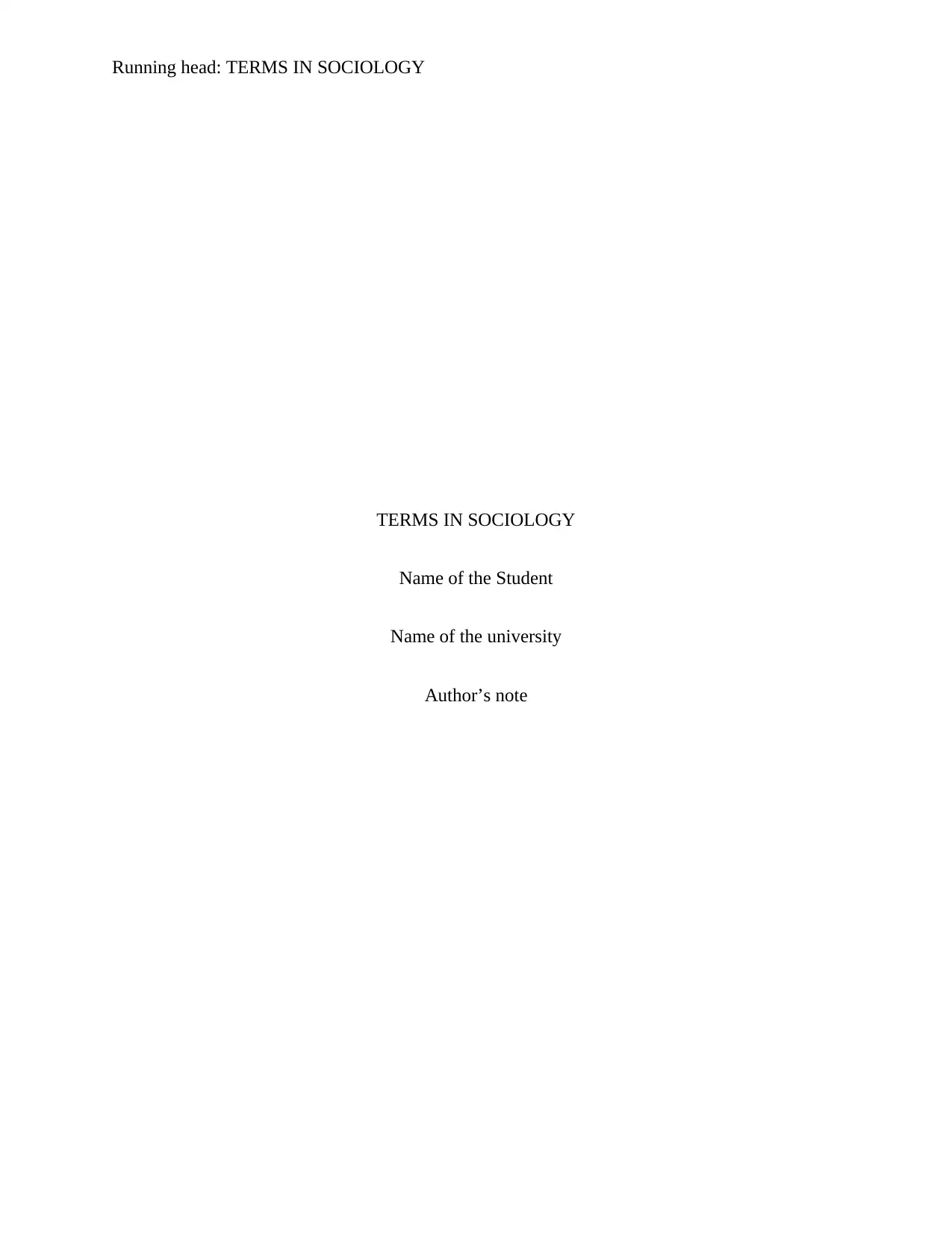
Running head: TERMS IN SOCIOLOGY
TERMS IN SOCIOLOGY
Name of the Student
Name of the university
Author’s note
TERMS IN SOCIOLOGY
Name of the Student
Name of the university
Author’s note
Paraphrase This Document
Need a fresh take? Get an instant paraphrase of this document with our AI Paraphraser
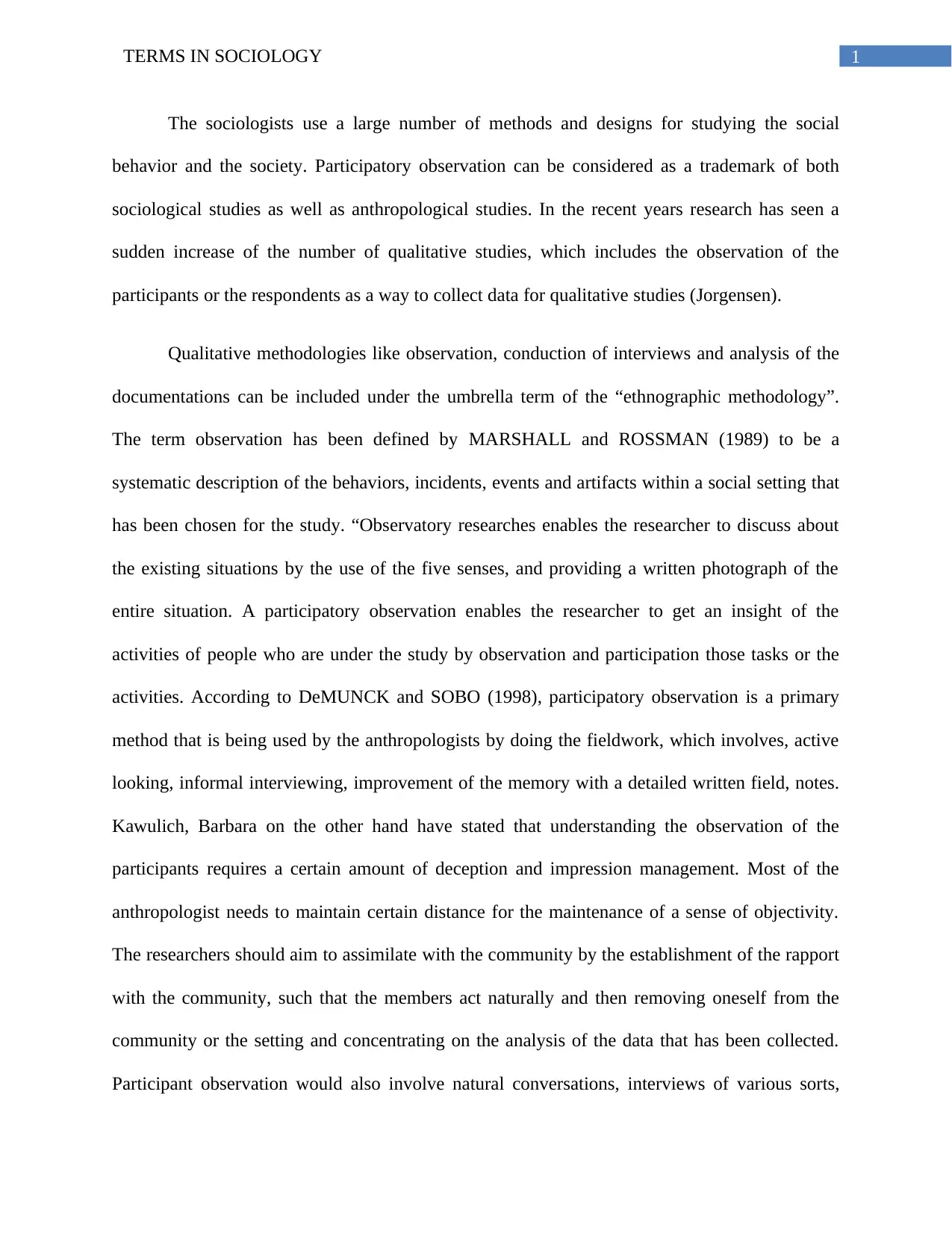
1TERMS IN SOCIOLOGY
The sociologists use a large number of methods and designs for studying the social
behavior and the society. Participatory observation can be considered as a trademark of both
sociological studies as well as anthropological studies. In the recent years research has seen a
sudden increase of the number of qualitative studies, which includes the observation of the
participants or the respondents as a way to collect data for qualitative studies (Jorgensen).
Qualitative methodologies like observation, conduction of interviews and analysis of the
documentations can be included under the umbrella term of the “ethnographic methodology”.
The term observation has been defined by MARSHALL and ROSSMAN (1989) to be a
systematic description of the behaviors, incidents, events and artifacts within a social setting that
has been chosen for the study. “Observatory researches enables the researcher to discuss about
the existing situations by the use of the five senses, and providing a written photograph of the
entire situation. A participatory observation enables the researcher to get an insight of the
activities of people who are under the study by observation and participation those tasks or the
activities. According to DeMUNCK and SOBO (1998), participatory observation is a primary
method that is being used by the anthropologists by doing the fieldwork, which involves, active
looking, informal interviewing, improvement of the memory with a detailed written field, notes.
Kawulich, Barbara on the other hand have stated that understanding the observation of the
participants requires a certain amount of deception and impression management. Most of the
anthropologist needs to maintain certain distance for the maintenance of a sense of objectivity.
The researchers should aim to assimilate with the community by the establishment of the rapport
with the community, such that the members act naturally and then removing oneself from the
community or the setting and concentrating on the analysis of the data that has been collected.
Participant observation would also involve natural conversations, interviews of various sorts,
The sociologists use a large number of methods and designs for studying the social
behavior and the society. Participatory observation can be considered as a trademark of both
sociological studies as well as anthropological studies. In the recent years research has seen a
sudden increase of the number of qualitative studies, which includes the observation of the
participants or the respondents as a way to collect data for qualitative studies (Jorgensen).
Qualitative methodologies like observation, conduction of interviews and analysis of the
documentations can be included under the umbrella term of the “ethnographic methodology”.
The term observation has been defined by MARSHALL and ROSSMAN (1989) to be a
systematic description of the behaviors, incidents, events and artifacts within a social setting that
has been chosen for the study. “Observatory researches enables the researcher to discuss about
the existing situations by the use of the five senses, and providing a written photograph of the
entire situation. A participatory observation enables the researcher to get an insight of the
activities of people who are under the study by observation and participation those tasks or the
activities. According to DeMUNCK and SOBO (1998), participatory observation is a primary
method that is being used by the anthropologists by doing the fieldwork, which involves, active
looking, informal interviewing, improvement of the memory with a detailed written field, notes.
Kawulich, Barbara on the other hand have stated that understanding the observation of the
participants requires a certain amount of deception and impression management. Most of the
anthropologist needs to maintain certain distance for the maintenance of a sense of objectivity.
The researchers should aim to assimilate with the community by the establishment of the rapport
with the community, such that the members act naturally and then removing oneself from the
community or the setting and concentrating on the analysis of the data that has been collected.
Participant observation would also involve natural conversations, interviews of various sorts,

2TERMS IN SOCIOLOGY
questionnaires, checklists and interviews. ‘Peopled ethnography” can be used as a term that
provides a description of the theoretical understanding of the settings by the utilization of the
vignettes, interviews and the product of the group members. “Peopled ethnography” is done by
the extensive description of the observed behavior (Balsiger, Philip, and Alexandre Lambelet).
Discussing about the strengths and limitations of using participatory observation, it can be said
that it allows for a detailed description, which can be interpreted to mean that one’s goal of
description behaviorism situations and intentions are understood by one’s informants. Moreover
it advances the feature of the data collection process. It assists in the development of new
hypothesis or the research question. There are also several disadvantages of an ethnographic
research. Sometimes the researcher might not find interest in interfering in whatever that is
happening out of eye of the public and that one should depend on the utilization of the main
informants. There can be issues related to the representation of the incidents or wrong
interpretations might occur if the investigators select the main informants who are community
leaders and hence biased information might be obtained. As stated by Lopez-Dicastillo, Olga,
and Maider participant observation leads to a wrong description in behavior research. As many
of the researchers have noted that the collected information does no symbolize tradition, as much
of the collected data by the investigator is based on the interest of the researcher. For example,
the reports collected about political activities would be more interesting than that of the eating
and the sleeping activities. Participatory observation is used as a backbone in the field work in a
varieties of subjects.
There are two types of naturalistic observation. Observations are a favorable methods
used in behaviorism studies. Overt observation can be referred as the researcher being open
about their intentions in the observatory field. The strength of these types of observation is that it
questionnaires, checklists and interviews. ‘Peopled ethnography” can be used as a term that
provides a description of the theoretical understanding of the settings by the utilization of the
vignettes, interviews and the product of the group members. “Peopled ethnography” is done by
the extensive description of the observed behavior (Balsiger, Philip, and Alexandre Lambelet).
Discussing about the strengths and limitations of using participatory observation, it can be said
that it allows for a detailed description, which can be interpreted to mean that one’s goal of
description behaviorism situations and intentions are understood by one’s informants. Moreover
it advances the feature of the data collection process. It assists in the development of new
hypothesis or the research question. There are also several disadvantages of an ethnographic
research. Sometimes the researcher might not find interest in interfering in whatever that is
happening out of eye of the public and that one should depend on the utilization of the main
informants. There can be issues related to the representation of the incidents or wrong
interpretations might occur if the investigators select the main informants who are community
leaders and hence biased information might be obtained. As stated by Lopez-Dicastillo, Olga,
and Maider participant observation leads to a wrong description in behavior research. As many
of the researchers have noted that the collected information does no symbolize tradition, as much
of the collected data by the investigator is based on the interest of the researcher. For example,
the reports collected about political activities would be more interesting than that of the eating
and the sleeping activities. Participatory observation is used as a backbone in the field work in a
varieties of subjects.
There are two types of naturalistic observation. Observations are a favorable methods
used in behaviorism studies. Overt observation can be referred as the researcher being open
about their intentions in the observatory field. The strength of these types of observation is that it
⊘ This is a preview!⊘
Do you want full access?
Subscribe today to unlock all pages.

Trusted by 1+ million students worldwide
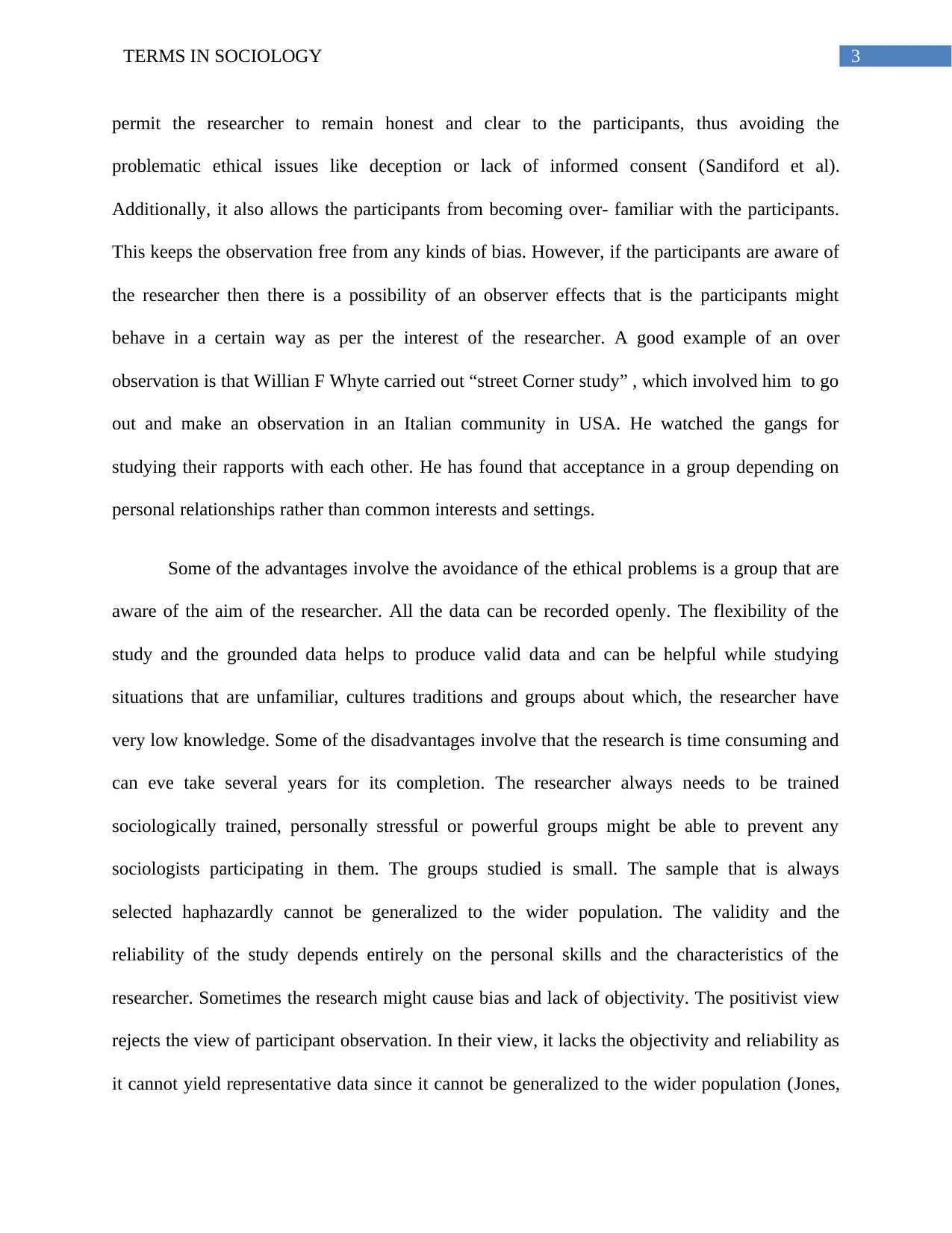
3TERMS IN SOCIOLOGY
permit the researcher to remain honest and clear to the participants, thus avoiding the
problematic ethical issues like deception or lack of informed consent (Sandiford et al).
Additionally, it also allows the participants from becoming over- familiar with the participants.
This keeps the observation free from any kinds of bias. However, if the participants are aware of
the researcher then there is a possibility of an observer effects that is the participants might
behave in a certain way as per the interest of the researcher. A good example of an over
observation is that Willian F Whyte carried out “street Corner study” , which involved him to go
out and make an observation in an Italian community in USA. He watched the gangs for
studying their rapports with each other. He has found that acceptance in a group depending on
personal relationships rather than common interests and settings.
Some of the advantages involve the avoidance of the ethical problems is a group that are
aware of the aim of the researcher. All the data can be recorded openly. The flexibility of the
study and the grounded data helps to produce valid data and can be helpful while studying
situations that are unfamiliar, cultures traditions and groups about which, the researcher have
very low knowledge. Some of the disadvantages involve that the research is time consuming and
can eve take several years for its completion. The researcher always needs to be trained
sociologically trained, personally stressful or powerful groups might be able to prevent any
sociologists participating in them. The groups studied is small. The sample that is always
selected haphazardly cannot be generalized to the wider population. The validity and the
reliability of the study depends entirely on the personal skills and the characteristics of the
researcher. Sometimes the research might cause bias and lack of objectivity. The positivist view
rejects the view of participant observation. In their view, it lacks the objectivity and reliability as
it cannot yield representative data since it cannot be generalized to the wider population (Jones,
permit the researcher to remain honest and clear to the participants, thus avoiding the
problematic ethical issues like deception or lack of informed consent (Sandiford et al).
Additionally, it also allows the participants from becoming over- familiar with the participants.
This keeps the observation free from any kinds of bias. However, if the participants are aware of
the researcher then there is a possibility of an observer effects that is the participants might
behave in a certain way as per the interest of the researcher. A good example of an over
observation is that Willian F Whyte carried out “street Corner study” , which involved him to go
out and make an observation in an Italian community in USA. He watched the gangs for
studying their rapports with each other. He has found that acceptance in a group depending on
personal relationships rather than common interests and settings.
Some of the advantages involve the avoidance of the ethical problems is a group that are
aware of the aim of the researcher. All the data can be recorded openly. The flexibility of the
study and the grounded data helps to produce valid data and can be helpful while studying
situations that are unfamiliar, cultures traditions and groups about which, the researcher have
very low knowledge. Some of the disadvantages involve that the research is time consuming and
can eve take several years for its completion. The researcher always needs to be trained
sociologically trained, personally stressful or powerful groups might be able to prevent any
sociologists participating in them. The groups studied is small. The sample that is always
selected haphazardly cannot be generalized to the wider population. The validity and the
reliability of the study depends entirely on the personal skills and the characteristics of the
researcher. Sometimes the research might cause bias and lack of objectivity. The positivist view
rejects the view of participant observation. In their view, it lacks the objectivity and reliability as
it cannot yield representative data since it cannot be generalized to the wider population (Jones,
Paraphrase This Document
Need a fresh take? Get an instant paraphrase of this document with our AI Paraphraser
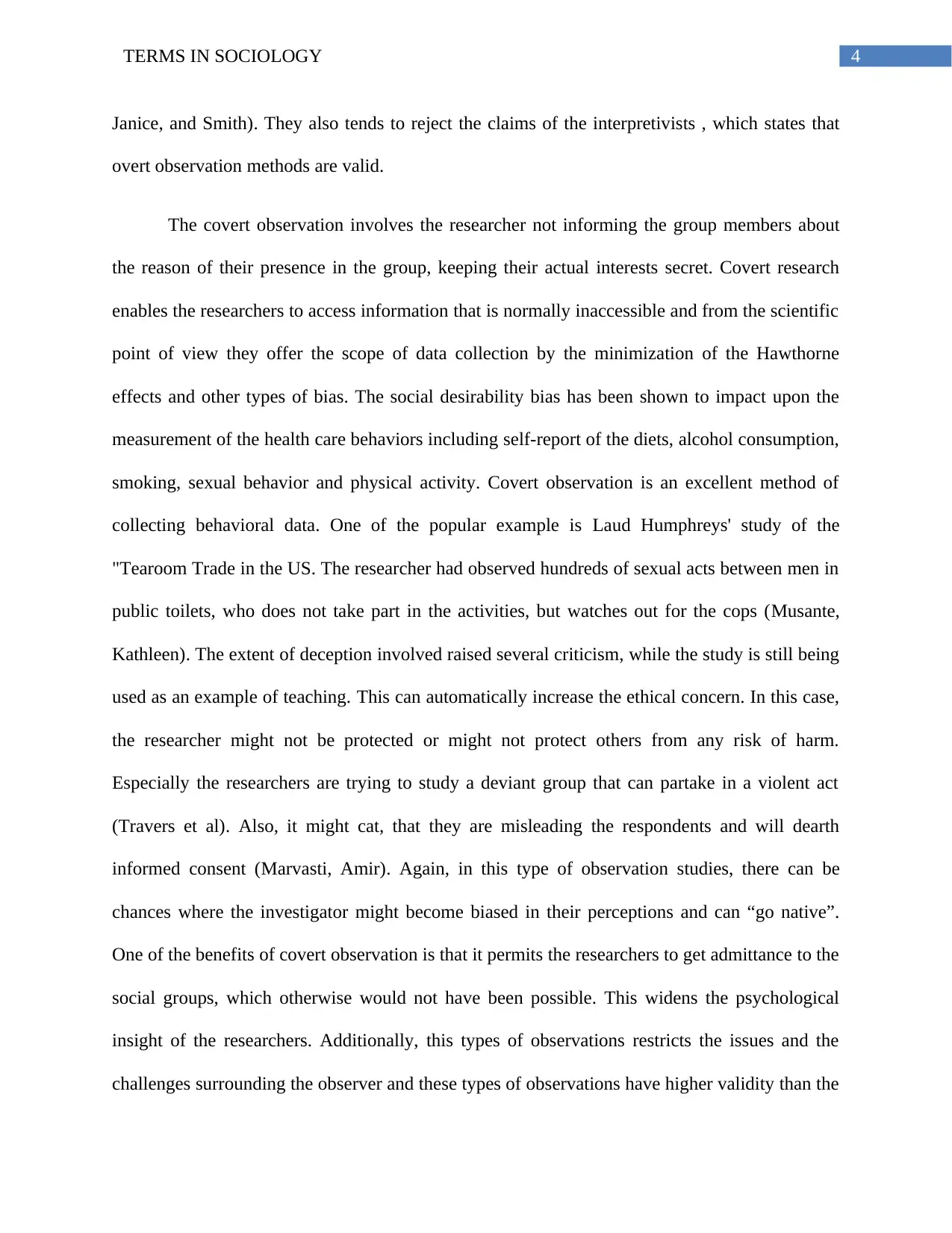
4TERMS IN SOCIOLOGY
Janice, and Smith). They also tends to reject the claims of the interpretivists , which states that
overt observation methods are valid.
The covert observation involves the researcher not informing the group members about
the reason of their presence in the group, keeping their actual interests secret. Covert research
enables the researchers to access information that is normally inaccessible and from the scientific
point of view they offer the scope of data collection by the minimization of the Hawthorne
effects and other types of bias. The social desirability bias has been shown to impact upon the
measurement of the health care behaviors including self-report of the diets, alcohol consumption,
smoking, sexual behavior and physical activity. Covert observation is an excellent method of
collecting behavioral data. One of the popular example is Laud Humphreys' study of the
"Tearoom Trade in the US. The researcher had observed hundreds of sexual acts between men in
public toilets, who does not take part in the activities, but watches out for the cops (Musante,
Kathleen). The extent of deception involved raised several criticism, while the study is still being
used as an example of teaching. This can automatically increase the ethical concern. In this case,
the researcher might not be protected or might not protect others from any risk of harm.
Especially the researchers are trying to study a deviant group that can partake in a violent act
(Travers et al). Also, it might cat, that they are misleading the respondents and will dearth
informed consent (Marvasti, Amir). Again, in this type of observation studies, there can be
chances where the investigator might become biased in their perceptions and can “go native”.
One of the benefits of covert observation is that it permits the researchers to get admittance to the
social groups, which otherwise would not have been possible. This widens the psychological
insight of the researchers. Additionally, this types of observations restricts the issues and the
challenges surrounding the observer and these types of observations have higher validity than the
Janice, and Smith). They also tends to reject the claims of the interpretivists , which states that
overt observation methods are valid.
The covert observation involves the researcher not informing the group members about
the reason of their presence in the group, keeping their actual interests secret. Covert research
enables the researchers to access information that is normally inaccessible and from the scientific
point of view they offer the scope of data collection by the minimization of the Hawthorne
effects and other types of bias. The social desirability bias has been shown to impact upon the
measurement of the health care behaviors including self-report of the diets, alcohol consumption,
smoking, sexual behavior and physical activity. Covert observation is an excellent method of
collecting behavioral data. One of the popular example is Laud Humphreys' study of the
"Tearoom Trade in the US. The researcher had observed hundreds of sexual acts between men in
public toilets, who does not take part in the activities, but watches out for the cops (Musante,
Kathleen). The extent of deception involved raised several criticism, while the study is still being
used as an example of teaching. This can automatically increase the ethical concern. In this case,
the researcher might not be protected or might not protect others from any risk of harm.
Especially the researchers are trying to study a deviant group that can partake in a violent act
(Travers et al). Also, it might cat, that they are misleading the respondents and will dearth
informed consent (Marvasti, Amir). Again, in this type of observation studies, there can be
chances where the investigator might become biased in their perceptions and can “go native”.
One of the benefits of covert observation is that it permits the researchers to get admittance to the
social groups, which otherwise would not have been possible. This widens the psychological
insight of the researchers. Additionally, this types of observations restricts the issues and the
challenges surrounding the observer and these types of observations have higher validity than the
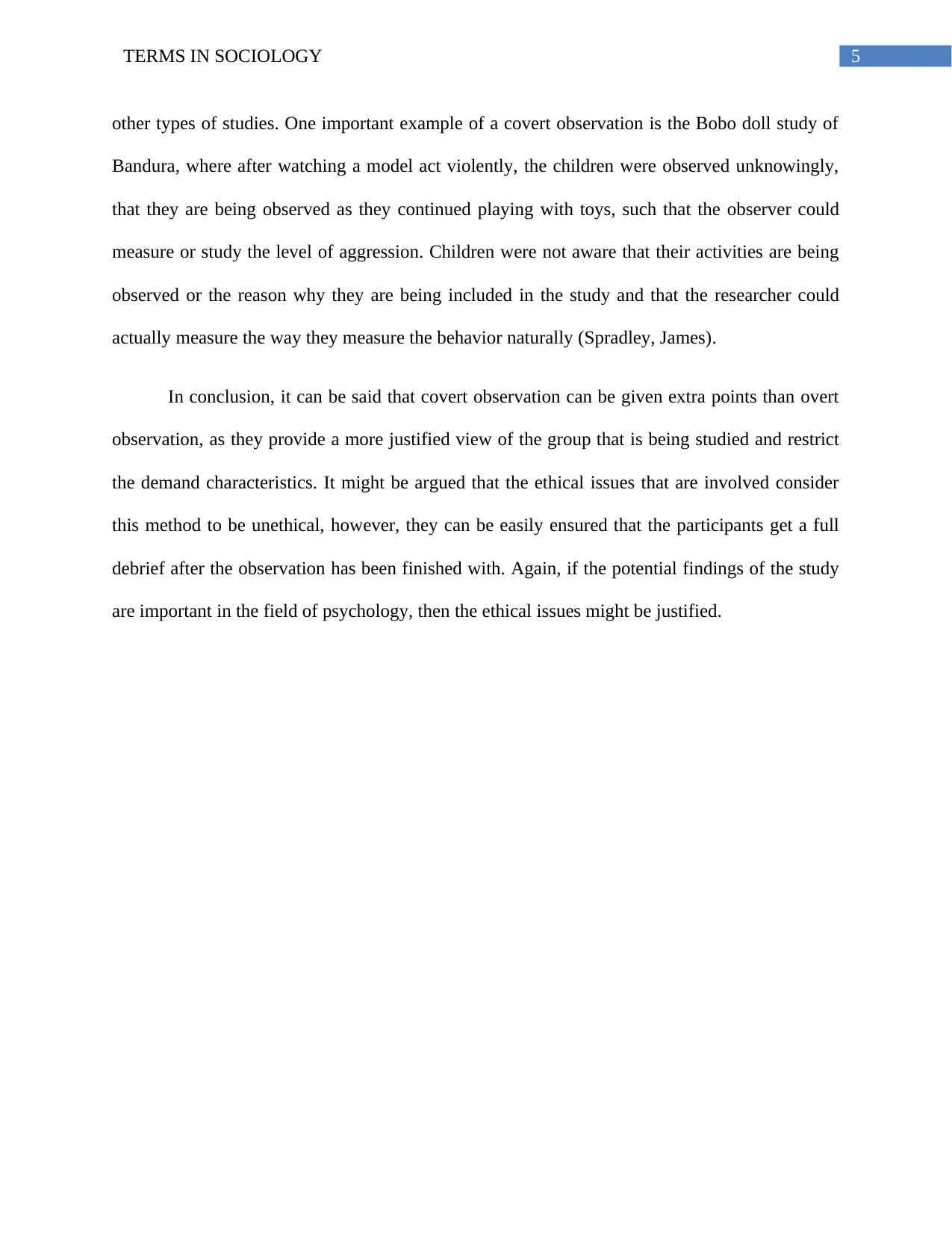
5TERMS IN SOCIOLOGY
other types of studies. One important example of a covert observation is the Bobo doll study of
Bandura, where after watching a model act violently, the children were observed unknowingly,
that they are being observed as they continued playing with toys, such that the observer could
measure or study the level of aggression. Children were not aware that their activities are being
observed or the reason why they are being included in the study and that the researcher could
actually measure the way they measure the behavior naturally (Spradley, James).
In conclusion, it can be said that covert observation can be given extra points than overt
observation, as they provide a more justified view of the group that is being studied and restrict
the demand characteristics. It might be argued that the ethical issues that are involved consider
this method to be unethical, however, they can be easily ensured that the participants get a full
debrief after the observation has been finished with. Again, if the potential findings of the study
are important in the field of psychology, then the ethical issues might be justified.
other types of studies. One important example of a covert observation is the Bobo doll study of
Bandura, where after watching a model act violently, the children were observed unknowingly,
that they are being observed as they continued playing with toys, such that the observer could
measure or study the level of aggression. Children were not aware that their activities are being
observed or the reason why they are being included in the study and that the researcher could
actually measure the way they measure the behavior naturally (Spradley, James).
In conclusion, it can be said that covert observation can be given extra points than overt
observation, as they provide a more justified view of the group that is being studied and restrict
the demand characteristics. It might be argued that the ethical issues that are involved consider
this method to be unethical, however, they can be easily ensured that the participants get a full
debrief after the observation has been finished with. Again, if the potential findings of the study
are important in the field of psychology, then the ethical issues might be justified.
⊘ This is a preview!⊘
Do you want full access?
Subscribe today to unlock all pages.

Trusted by 1+ million students worldwide
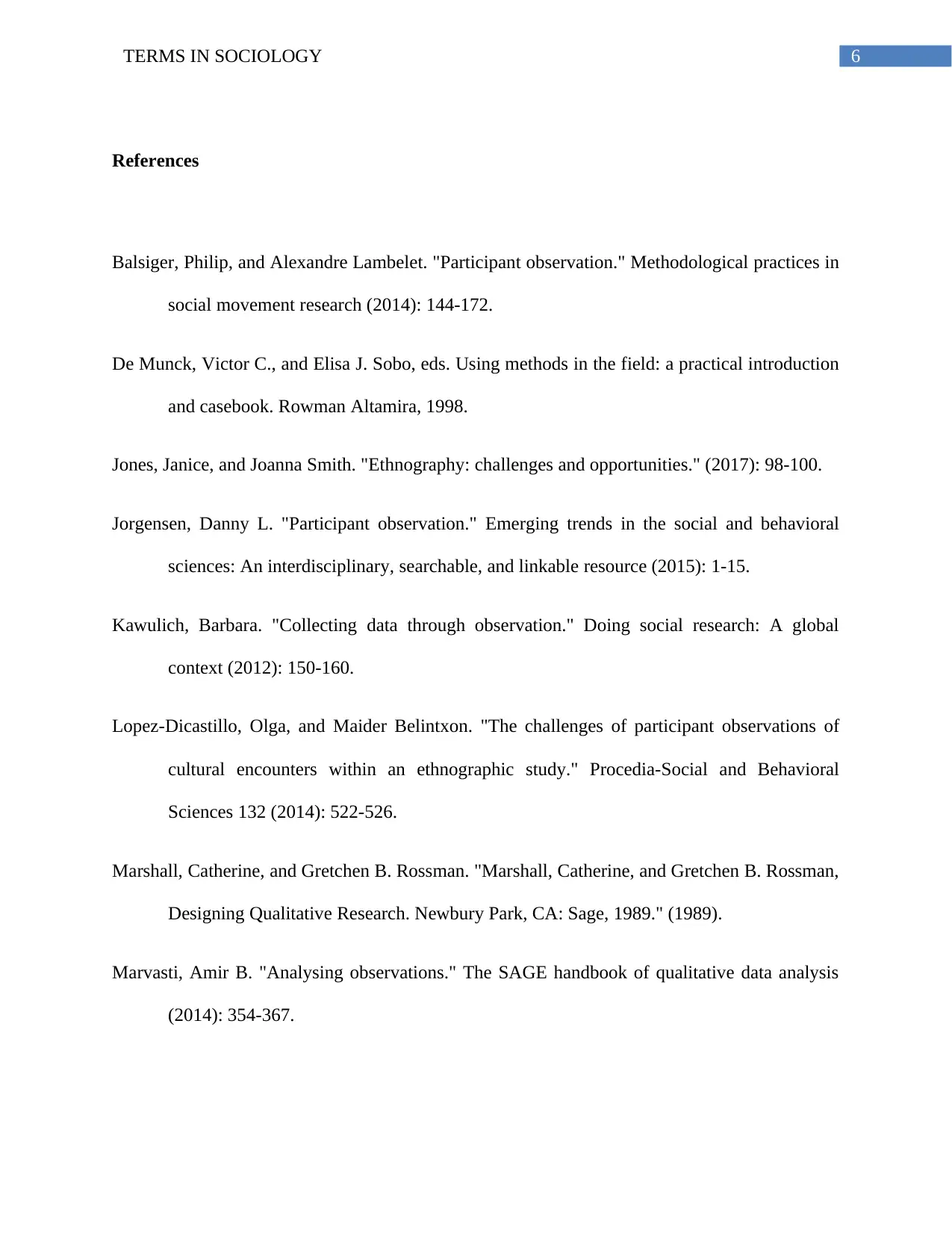
6TERMS IN SOCIOLOGY
References
Balsiger, Philip, and Alexandre Lambelet. "Participant observation." Methodological practices in
social movement research (2014): 144-172.
De Munck, Victor C., and Elisa J. Sobo, eds. Using methods in the field: a practical introduction
and casebook. Rowman Altamira, 1998.
Jones, Janice, and Joanna Smith. "Ethnography: challenges and opportunities." (2017): 98-100.
Jorgensen, Danny L. "Participant observation." Emerging trends in the social and behavioral
sciences: An interdisciplinary, searchable, and linkable resource (2015): 1-15.
Kawulich, Barbara. "Collecting data through observation." Doing social research: A global
context (2012): 150-160.
Lopez-Dicastillo, Olga, and Maider Belintxon. "The challenges of participant observations of
cultural encounters within an ethnographic study." Procedia-Social and Behavioral
Sciences 132 (2014): 522-526.
Marshall, Catherine, and Gretchen B. Rossman. "Marshall, Catherine, and Gretchen B. Rossman,
Designing Qualitative Research. Newbury Park, CA: Sage, 1989." (1989).
Marvasti, Amir B. "Analysing observations." The SAGE handbook of qualitative data analysis
(2014): 354-367.
References
Balsiger, Philip, and Alexandre Lambelet. "Participant observation." Methodological practices in
social movement research (2014): 144-172.
De Munck, Victor C., and Elisa J. Sobo, eds. Using methods in the field: a practical introduction
and casebook. Rowman Altamira, 1998.
Jones, Janice, and Joanna Smith. "Ethnography: challenges and opportunities." (2017): 98-100.
Jorgensen, Danny L. "Participant observation." Emerging trends in the social and behavioral
sciences: An interdisciplinary, searchable, and linkable resource (2015): 1-15.
Kawulich, Barbara. "Collecting data through observation." Doing social research: A global
context (2012): 150-160.
Lopez-Dicastillo, Olga, and Maider Belintxon. "The challenges of participant observations of
cultural encounters within an ethnographic study." Procedia-Social and Behavioral
Sciences 132 (2014): 522-526.
Marshall, Catherine, and Gretchen B. Rossman. "Marshall, Catherine, and Gretchen B. Rossman,
Designing Qualitative Research. Newbury Park, CA: Sage, 1989." (1989).
Marvasti, Amir B. "Analysing observations." The SAGE handbook of qualitative data analysis
(2014): 354-367.
Paraphrase This Document
Need a fresh take? Get an instant paraphrase of this document with our AI Paraphraser
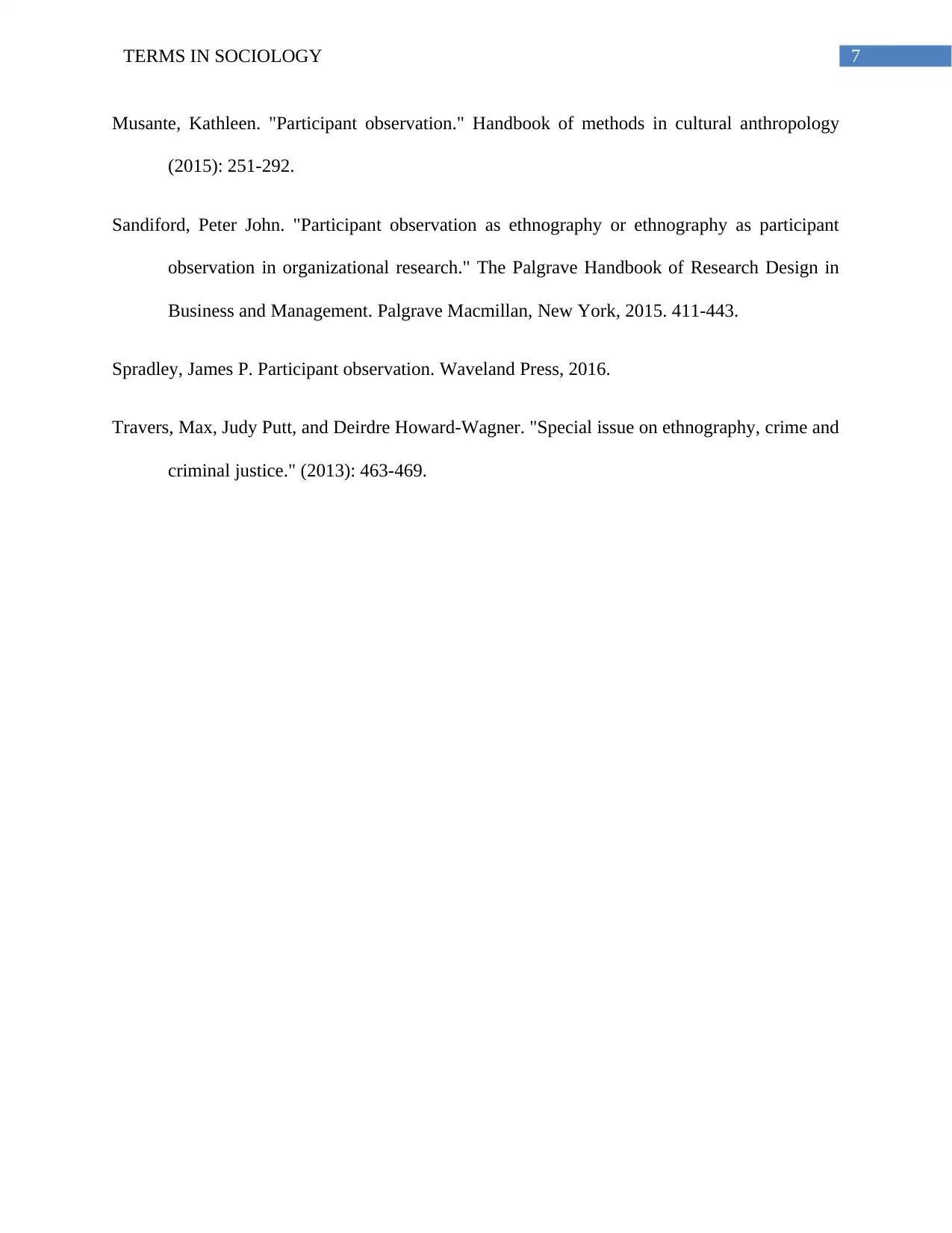
7TERMS IN SOCIOLOGY
Musante, Kathleen. "Participant observation." Handbook of methods in cultural anthropology
(2015): 251-292.
Sandiford, Peter John. "Participant observation as ethnography or ethnography as participant
observation in organizational research." The Palgrave Handbook of Research Design in
Business and Management. Palgrave Macmillan, New York, 2015. 411-443.
Spradley, James P. Participant observation. Waveland Press, 2016.
Travers, Max, Judy Putt, and Deirdre Howard-Wagner. "Special issue on ethnography, crime and
criminal justice." (2013): 463-469.
Musante, Kathleen. "Participant observation." Handbook of methods in cultural anthropology
(2015): 251-292.
Sandiford, Peter John. "Participant observation as ethnography or ethnography as participant
observation in organizational research." The Palgrave Handbook of Research Design in
Business and Management. Palgrave Macmillan, New York, 2015. 411-443.
Spradley, James P. Participant observation. Waveland Press, 2016.
Travers, Max, Judy Putt, and Deirdre Howard-Wagner. "Special issue on ethnography, crime and
criminal justice." (2013): 463-469.
1 out of 8
Related Documents
Your All-in-One AI-Powered Toolkit for Academic Success.
+13062052269
info@desklib.com
Available 24*7 on WhatsApp / Email
![[object Object]](/_next/static/media/star-bottom.7253800d.svg)
Unlock your academic potential
Copyright © 2020–2026 A2Z Services. All Rights Reserved. Developed and managed by ZUCOL.





